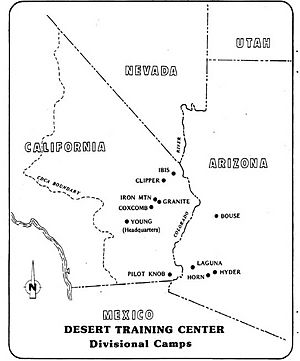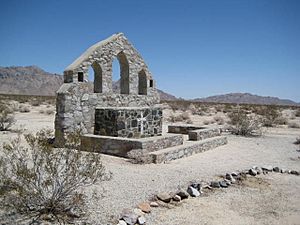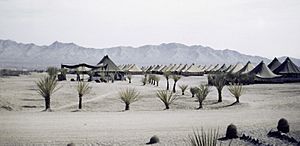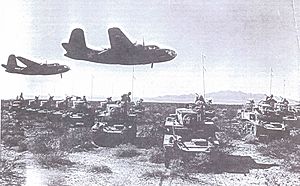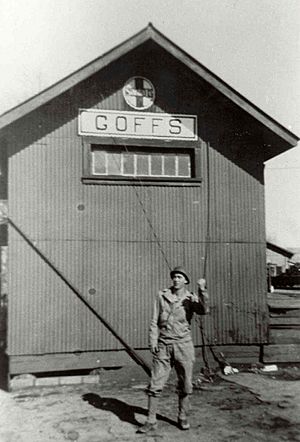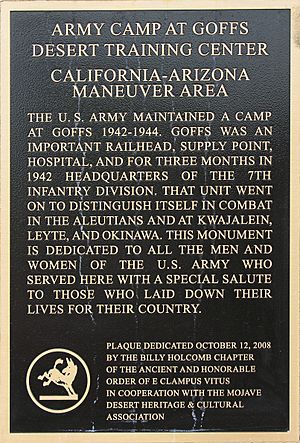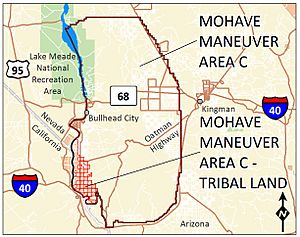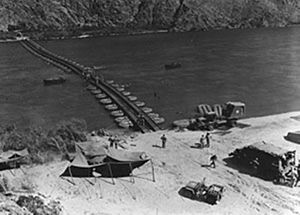Desert Training Center facts for kids
Quick facts for kids Desert Training Center |
|
|---|---|
| Part of United States Army | |
| Southern California/Western Arizona | |
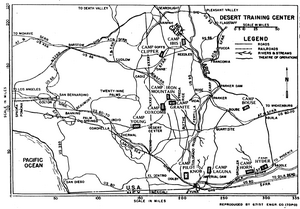
Map of Desert Training Center
|
|
| Coordinates | 33°40′N 115°43′W / 33.667°N 115.717°W |
| Type | Army Training Area |
| Site history | |
| Built | 1942 |
| In use | 1942–1944 |
| Garrison information | |
| Past commanders |
Major General George S. Patton, Jr. |
The Desert Training Center (DTC) was a special training area during World War II. It was also known as the California–Arizona Maneuver Area (CAMA). This huge training ground was set up in 1942 in the Mojave Desert and Sonoran Desert. Most of it was in Southern California and Western Arizona.
The main goal of the DTC was to teach United States Army and Army Air Forces soldiers how to live and fight in the desert. They also tested new equipment and developed ways to train troops for desert battles. This training was very important for units fighting in the 1942–1943 North African campaign. The center was enormous, stretching from near Pomona, California all the way to Phoenix, Arizona. It also reached south to Yuma, Arizona and north into Nevada.
Contents
History of the Desert Training Center
This training area was the biggest military training ground ever used for practice battles. The main headquarters for the DTC was called Camp Young. It was located near Chiriaco Summit, between Indio and Desert Center. Camp Young became the largest army post in the world.
General Patton's Role
Major General George S. Patton Jr. was the first leader of the DTC. He grew up in Southern California and knew the desert well. He had even practiced army maneuvers there in the 1930s. Patton's first job was to find other desert spots for large-scale training. This training was needed to prepare American soldiers to fight against the German Afrika Korps in North Africa.
Patton and his team chose many places in the desert for tent camps. These camps were set up so that each army unit could train on its own. They also picked spots for airfields, hospitals, and supply areas. The plan was for each division to train in its own area. Then, they would join a bigger exercise at Palen Pass. After this big practice, the trained units would leave, and new units would arrive to start their training.
Changing Missions
By March 1943, the fighting in North Africa was almost over. Because of this, the main job of the DTC changed. By mid-1943, the soldiers who had trained for the desert were now fighting all over the world. So, the center's name was changed to the California-Arizona Maneuver Area (C-AMA or CAMA).
The CAMA's new purpose was to train combat troops and support units. They practiced in conditions similar to what they might face overseas. The CAMA became even larger, covering about 350 miles wide and 250 miles long. By early 1944, there weren't enough support units. So, it was decided that the large training exercises in CAMA would stop by April 15, 1944. The center officially closed on July 1, 1944.
- The center started on April 1, 1942.
- It was renamed California-Arizona Maneuver Area on October 20, 1943.
- It closed on July 1, 1944.
Facilities of the Training Center
The Desert Training Center had many different types of facilities. These included camps for army divisions, supply depots, airfields, and hospitals.
Army Divisional Camps
These were the main camps where army divisions trained:
- Camp Bouse (a secret camp)
- Camp Clipper and Camp Essex
- Camp Coxcomb
- Camp Granite
- Camp Hyder
- Camp Horn
- Camp Ibis
- Camp Iron Mountain
- Camp Laguna
- Camp Pilot Knob
- Camp Young (the headquarters)
Army Depots and Supply Points
These places stored and distributed supplies for the troops:
- Camp Freda Quartermaster Depot
- Camp Desert Center
- Camp Goffs – also used for infantry training.
- Pomona Ordnance Depot
- San Bernardino Engineer Depot
Army Airfields
Many airfields were built to support the training. Some were major bases, while others were smaller fields.
- Major airfields:
- Blythe Army Air Base
- Desert Center Army Airfield
- Thermal Army Airfield
- Rice Army Airfield
- Shavers Summit Army Airfield (now Chiriaco Summit Airport)
- Minor airfields (many are now abandoned):
- Camp Coxcomb Army Field
- Dateland Air Force Auxiliary Field
- Camp Essex Army Field
- Camp Goffs Army Field
- Camp Ibis Army Field
- Camp Iron Mountain Army Field
- Laguna Army Airfield (still in use today)
- Camp Horn Army Airfield
Hospitals
Several hospitals were set up to care for the soldiers:
- Banning General Hospital in Banning, CA
- Camp Freda Hospital
- Camp Desert Center Hospital
- Camp Goffs Hospital
- Torney General Hospital in Palm Springs
- Needles Station Hospital
- Cherry Valley Hospital in Beaumont
Mohave Maneuver Area C
In May 1964, a part of the old Desert Training Center was used again for a large practice exercise called "Desert Strike." The former Mohave Maneuver Area C was part of this training ground. It was used for two weeks of big maneuvers, including river crossings. This area was huge, covering over 781,000 acres in Mohave County, Arizona.
Present Day Sites
Today, you can visit most of the old training sites. However, some are hard to reach. At many camp sites, only the old streets, sidewalks, building foundations, and rock patterns remain. You might also find old trash dumps.
Monuments have been put up at some of the camp sites to remember their history. Some areas within the former CAMA are fenced off with danger signs. These signs warn about unexploded bombs or other old military items that could still be there.
The General George S. Patton Memorial Museum is located near where Camp Young used to be. It tells the story of the Desert Training Center and General Patton.
California Historical Landmarks
Many sites of the Desert Training Center have special markers called California Historical Landmarks. These markers explain the history of each camp. All of them are part of "NO. 985 DESERT TRAINING CENTER, CALIFORNIA–ARIZONA MANEUVER AREA (ESTABLISHED BY MAJOR GENERAL GEORGE S. PATTON, JR.)."
- Camp Pilot Knob – Imperial: This camp was used by the 85th Infantry Division and other units. They trained here from June to December 1943 for their roles in freeing Europe.
- Camp Young – Riverside: This was the main headquarters. It started in 1942 and covered 18,000 square miles. It was the biggest military training ground ever. Over one million men trained at its eleven sub-camps.
- Camp Granite – Riverside: This camp was set up in Spring 1942. It was one of twelve camps built in the desert to train U.S. troops for World War II. Over one million American soldiers trained in this tough environment.
- Camp Coxcomb – Riverside: Also established in Spring 1942, Camp Coxcomb was another of the twelve desert camps. It helped harden and train troops for battle.
- Camp Iron Mountain – San Bernardino: This camp was also set up in Spring 1942. The 3rd Armored Division and parts of the 4th, 5th, 6th, and 7th Armored Divisions trained here. A unique feature is a huge relief map built into the desert floor, which can still be seen.
- Camp Clipper – San Bernardino: This camp was established in Spring 1942. The 33rd and 93rd Infantry Divisions trained here.
- Camp Ibis – San Bernardino: Camp Ibis was another of the eleven camps. The 440th AAA AW Battalion trained here before going to England and fighting in Normandy.


